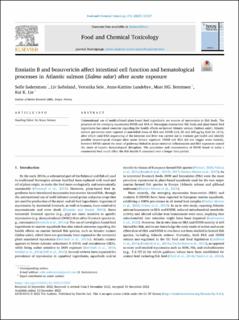| dc.contributor.author | Söderström, Sofie Karin | |
| dc.contributor.author | Søfteland, Liv Ingeborg Rosvoll | |
| dc.contributor.author | Sele, Veronika | |
| dc.contributor.author | Lundebye, Anne-Katrine | |
| dc.contributor.author | Berntssen, Marc HG | |
| dc.contributor.author | Lie, Kai Kristoffer | |
| dc.date.accessioned | 2023-09-21T11:43:35Z | |
| dc.date.available | 2023-09-21T11:43:35Z | |
| dc.date.created | 2023-01-26T16:14:39Z | |
| dc.date.issued | 2023 | |
| dc.identifier.citation | Food and Chemical Toxicology (FCT). 2023, . | en_US |
| dc.identifier.issn | 0278-6915 | |
| dc.identifier.uri | https://hdl.handle.net/11250/3091072 | |
| dc.description.abstract | Unintentional use of mold-infested plant-based feed ingredients are sources of mycotoxins in fish feeds. The presence of the emerging mycotoxins ENNB and BEA in Norwegian commercial fish feeds and plant-based feed ingredients has raised concerns regarding the health effects on farmed Atlantic salmon (Salmon salar). Atlantic salmon pre-smolts were exposed to non-lethal doses of BEA and ENNB (ctrl, 50 and 500 μg/kg feed for 12 h), after which total RNA sequencing of the intestine and liver was carried out to evaluate gut health and identify possible hepatological changes after acute dietary exposure. ENNB and BEA did not trigger acute toxicity, however ENNB caused the onset of pathways linked to acute intestinal inflammation and BEA exposures caused the onset of hepatic hematological disruption. The prevalence and concentration of ENNB found in today's commercial feed could affect the fish health if consumed over a longer time-period. | en_US |
| dc.language.iso | eng | en_US |
| dc.title | Enniatin B and beauvericin affect intestinal cell function and hematological processes in Atlantic salmon (Salmo salar) after acute exposure | en_US |
| dc.title.alternative | Enniatin B and beauvericin affect intestinal cell function and hematological processes in Atlantic salmon (Salmo salar) after acute exposure | en_US |
| dc.type | Peer reviewed | en_US |
| dc.type | Journal article | en_US |
| dc.description.version | publishedVersion | en_US |
| dc.source.pagenumber | 14 | en_US |
| dc.source.journal | Food and Chemical Toxicology (FCT) | en_US |
| dc.identifier.doi | 10.1016/j.fct.2022.113557 | |
| dc.identifier.cristin | 2115961 | |
| dc.relation.project | Norges forskningsråd: 281032 | en_US |
| cristin.ispublished | true | |
| cristin.fulltext | original | |
| cristin.qualitycode | 1 | |
